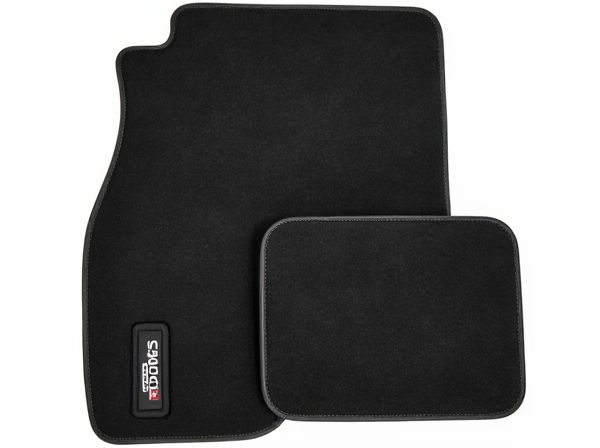
Photo illustration: Molded Floor Mat vs Flat Mat
Molded floor mats provide a custom fit with raised edges that trap dirt, water, and debris, protecting your vehicle's carpet more effectively than flat mats. Flat mats offer basic protection and are typically easier to clean, but they may allow spills to spread, potentially damaging your floor. Choosing molded mats ensures your interior stays cleaner and improves overall durability, enhancing your driving experience.
Table of Comparison
| Feature | Molded Floor Mat | Flat Floor Mat |
|---|---|---|
| Design | 3D contoured to fit car floor shape | Simple, flat design |
| Protection | Superior; covers edges and channels spills | Basic; limited spill containment |
| Material | Heavy-duty rubber or thermoplastic | Carpet or thin rubber |
| Durability | High; resists wear, tear, and weather | Moderate; prone to wear over time |
| Cleaning | Easy; rinse or wipe clean | Requires vacuuming and spot cleaning |
| Price | Higher cost; premium protection | Lower cost; basic coverage |
Introduction to Molded Floor Mats vs Flat Mats
Molded floor mats are precisely designed to conform to the contours of a vehicle's floor, providing enhanced protection against dirt, water, and debris with raised edges and custom fit. Flat mats, on the other hand, feature a simple, uniform design that lies flat and may require trimming for a proper fit, offering basic coverage. The choice between molded and flat floor mats depends on the level of protection needed, with molded mats typically delivering superior durability and cleanliness.
Key Differences Between Molded and Flat Mats
Molded floor mats feature raised edges and contoured designs tailored to fit the specific dimensions of vehicle floors, providing enhanced protection against dirt, spills, and wear. Flat mats, made from flexible materials like carpet or rubber, offer a universal fit but lack the precise coverage and retention features of molded mats. The key differences include durability, custom fit, and spill containment, with molded mats excelling in heavy-duty protection and flat mats favoring ease of installation and versatility.
Material and Durability Comparison
Molded floor mats are typically made from heavy-duty thermoplastic elastomers or rubber compounds that provide superior resistance to wear, chemicals, and extreme temperatures, ensuring long-lasting durability. Flat mats often use simpler materials like carpet fibers or thin rubber, which can wear out faster and offer less protection against spills and debris. The three-dimensional molding in molded mats enhances structural integrity, preventing curling and cracking, unlike flat mats that may degrade more quickly under heavy use.
Fit and Coverage: Which Offers Better Protection?
Molded floor mats provide superior fit and coverage by conforming precisely to a vehicle's floor contours, ensuring maximum protection against dirt, spills, and wear. Flat mats, while often more affordable, offer less customized coverage and may leave gaps that expose vehicle carpet to damage and stains. Choosing molded mats enhances durability and protection by fully covering critical areas and preventing debris accumulation underfoot.
Installation Process: Molded vs Flat Mats
Molded floor mats are designed to fit the exact contours of a vehicle's floor, allowing for a precise installation that snaps securely into place, minimizing movement and maximizing coverage. Flat mats require manual trimming or multiple mats to cover the area adequately, making the installation process less precise and potentially leaving gaps. The molded fit of custom mats simplifies attachment using factory clips or anchors, while flat mats typically depend on friction or generic anchoring systems for stability.
Aesthetic Appeal and Design Options
Molded floor mats offer a three-dimensional design that contours to vehicle floors, providing a sleek and custom-fit appearance that enhances interior aesthetics. Flat mats, while simpler and more versatile, feature a range of colors and patterns but lack the tailored, sculpted look of molded mats. Choosing between molded and flat mats depends on the desired balance between a precise fit and diverse design options for vehicle interiors.
Cleaning and Maintenance Ease
Molded floor mats offer superior protection with raised edges that trap dirt, spills, and debris, making them easier to clean by simply rinsing off with water or wiping down with a damp cloth. Flat mats, while generally thinner and lighter, tend to absorb dirt and stains more easily, requiring more intensive scrubbing and frequent washing to maintain cleanliness. The low-maintenance design of molded mats reduces overall effort and time spent on upkeep, making them a practical choice for high-traffic or messy environments.
Cost Comparison: Value for Money
Molded floor mats typically cost more upfront than flat mats due to their custom fit and durable materials, offering enhanced protection and longevity that justifies the investment. Flat mats are generally cheaper and provide basic coverage but may require frequent replacement, resulting in higher long-term expenses. Evaluating value for money depends on personal needs for durability, maintenance frequency, and fit precision in vehicle floors.
Pros and Cons of Molded Floor Mats
Molded floor mats offer superior protection with raised edges that contain spills and debris, making them ideal for heavy-duty use and harsh weather conditions. Their custom fit enhances vehicle interior aesthetics and prevents shifting, but they tend to be more expensive and less flexible than flat mats. Cleaning molded mats is straightforward due to their durable materials, though they can sometimes trap dirt in grooves, requiring more thorough maintenance.
Pros and Cons of Flat Mats
Flat floor mats offer benefits such as lightweight design, easier installation, and lower cost compared to molded mats. They provide versatility in fit, allowing users to trim edges for custom sizing, but lack the deep grooves and raised edges that capture dirt and liquids effectively. Flat mats are less durable and may shift during use, reducing protection against spills and debris.
 caratoz.com
caratoz.com